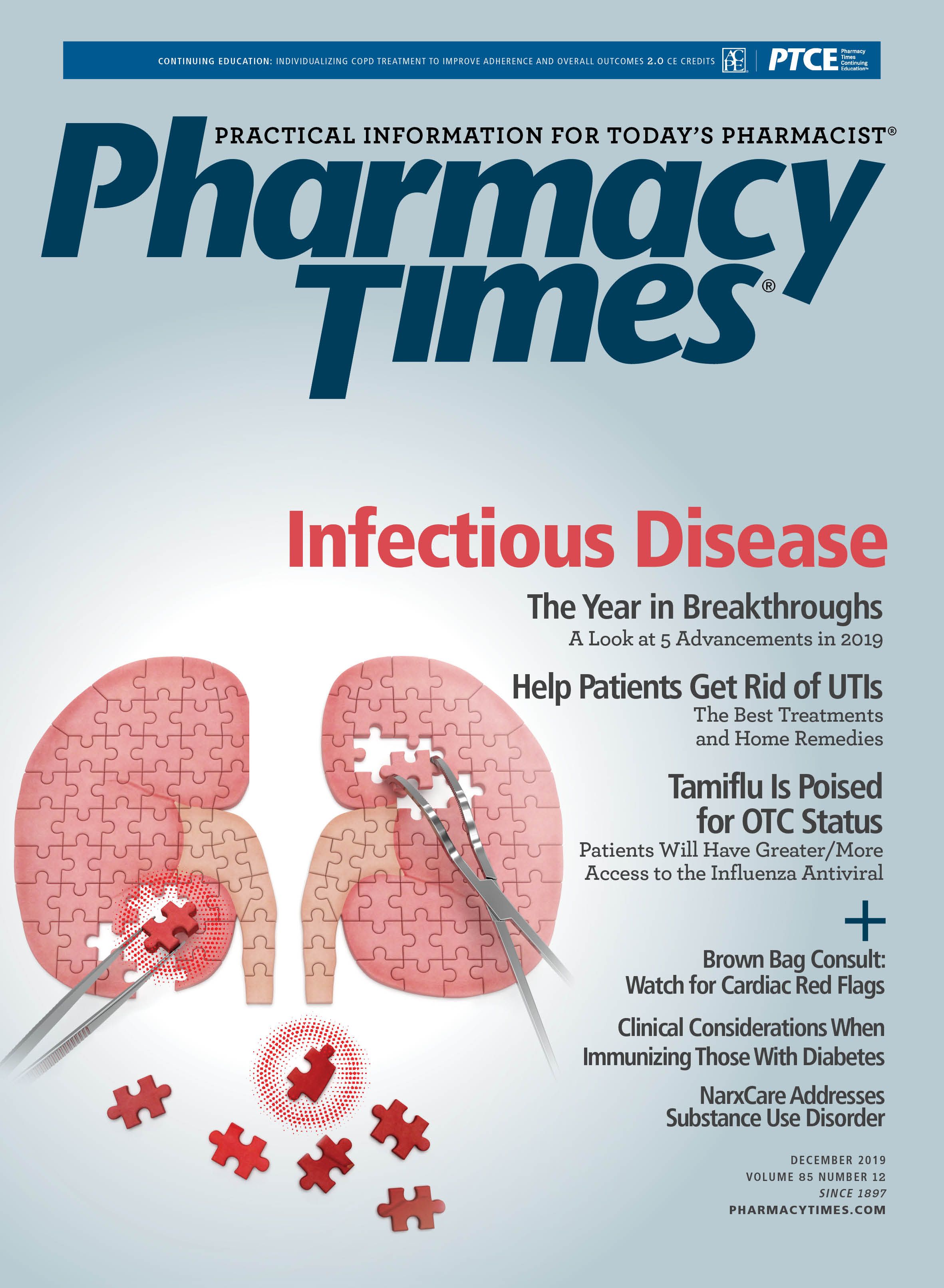Publication
Article
Pharmacy Times
Aimovig Can Cut the Number of Migraine Days
Author(s):
The human monoclonal antibody helps treat the painful and often debilitating condition.
Patients commonly describe migraine as a pulsing or throbbing sensation on 1 side of the head that is accompanied by nausea, vomiting, and sensitivity to light and sound. They may experience warning symptoms, known as aura, that are characterized by blind spots, flashes of light, or unilateral paresthesia. Migraines are typically recurring and may be triggered by a number of factors, including alcohol, changes in environment or wake-sleep patterns, food additives, foods, medications, sensory stimuli, and stress.1
The FDA approved the Aimovig (erenumab-aooe) injection from Amgen Inc for the preventive treatment of migraines in adults in May 2018. “We need new treatments for this painful and often debilitating condition,” Eric Bastings, MD, deputy director of the Division of Neurology Products in the FDA’s Center for Drug Evaluation and Research, said in a statement. “Aimovig provides patients with a novel option for reducing the number of days with migraine.”2
MECHANISM OF ACTION
Aimovig is a human immunoglobulin G2 monoclonal antibody that has high-affinity binding to the calcitonin gene-related peptide (CGRP) receptor and antagonizes CGRP receptor function. The agent is produced using recombinant DNA technology in Chinese hamster ovary cells. It is composed of 2 heavy chains, each containing 456 amino acids, and 2 light chains of the λ subclass, each containing 216 amino acids, with an approximate molecular weight of 150 kDa.3
DOSAGE AND ADMINISTRATION
The recommended dosage of Aimovig is 70 mg injected subcutaneously once monthly. Some patients may benefit from a dosage of 140 mg injected subcutaneously once monthly, which is administered as 2 consecutive subcutaneous injections of 70 mg each.
Aimovig is intended for patient self-administration. Prior to patient use, pharmacists should provide proper training to the patient or caregiver on preparing and administering Aimovig using the single-dose prefilled autoinjector or single-dose prefilled syringe, including aseptic technique.
CLINICAL STUDIES
Aimovig’s effectiveness for the preventive treatment of migraine was assessed in 3 double-blind, placebo-controlled, randomized studies. Two of the studies focused on patients with episodic migraine (4-14 migraine days per month), and the other study focused on patients with chronic migraine (≥15 headache days per month with ≥8 migraine days per month). The first and second studies compared Aimovig with placebo. In the first study, patients experienced 1 to 2 fewer monthly migraine days over a course of 6 months than those on a placebo. In the second study, patients experienced 1 fewer migraine day per month over the course of 3 months than those on placebo. The third study’s results showed that patients experienced about 2.5 fewer monthly migraine days compared with those on placebo.3
CONTRAINDICATIONS, PRECAUTIONS, AND WARNINGS
No contraindications, precautions, or warnings are associated with Aimovig.
DRUG INTERACTION STUDIES
Oral Contraceptives
In an open-label drug interaction study in healthy female volunteers, Aimovig did not affect the pharmacokinetics of a combined oral contraceptive containing ethinyl estradiol and norgestimate.
P450 Enzymes
Aimovig is not metabolized by cytochrome P450 enzymes. Therefore, interactions with medications that are inducers, inhibitors, or substrates of cytochrome 450 enzymes are unlikely.
Sumatriptan
In a study in healthy volunteers, concomitant administration of Aimovig with sumatriptan had no effect on the pharmacokinetics of sumatriptan.
USE IN SPECIFIC POPULATIONS
Geriatric Patients
Clinical studies of Aimovig did not include sufficient numbers of patients 65 years and older to determine whether they respond differently from younger patients. In general, practitioners should exercise caution in dose selection for an elderly patient, usually starting at the low end of the dosing range, reflecting the greater frequency of decreased cardiac, hepatic, or renal function and of concomitant disease or other drug therapy.
Patients Who Are Lactating
There are no data on the presence of Aimovig in human milk, the effects on the breast-fed infant, or the effects on milk production.
Pediatric Patients
The safety and effectiveness in pediatric patients have not been established.
Pregnant Patients
Adequate data are not available regarding the developmental risk associated with the use of Aimovig in pregnant women. No adverse effects on offspring were observed when pregnant monkeys were administered Aimovig throughout gestation. Serum Aimovig exposures in pregnant monkeys were greater than those in humans at clinical doses. No adverse effects on offspring were observed.
In the US general population, the estimated risk of major birth defects and miscarriage in clinically recognized pregnancies is 2% to 4% and 15% to 20%, respectively. The estimated rates of major birth defects (2.2%-2.9%) and miscarriage (17.0%) among deliveries to women with migraines are similar to rates reported in women without migraines.
ADVERSE EVENTS
The most common adverse reactions, which occurred ≥3% of the time in those taking Aimovig but more often than those on the placebo, were constipation and injection site reactions. The most frequent injection site reactions were erythema, pain, and pruritus.
STORAGE AND HANDLING
Store Aimovig under refrigerated conditions at 2°C to 8°C (36°F-46°F) in the original carton to protect from light until time of use. The drug should not be frozen or shaken. If removed from the refrigerator, Aimovig should be kept at room temperature (up to 25°C [77°F]) in the original carton and must be used within 7 days. Discard Aimovig if it is left at room temperature for more than 7 days.
Christa Eans, PharmD, MPBA, CSP, is the manager of pharmacy operations at RareMed Solutions in Pittsburgh, Pennsylvania.
REFERENCES
1. Migraine. Mayo Clinic website. mayoclinic.org/diseases-conditions/migraineheadache/symptoms-causes/syc-20360201. Accessed November 24, 2019.
2. FDA approves novel preventive treatment for migraine [news release]. Silver Spring, MD: FDA; May 22, 2018. www.fda.gov/newsevents/newsroom/pressannouncements/ucm608120.htm. Accessed November 24, 2019.
3. Aimovig [prescribing information]. Thousand Oaks, CA: Amgen Inc; 2018. https://www.pi.amgen.com/~/media/amgen/repositorysites/pi-amgen-com/aimovig/aimovig_pi_hcp_english.ashx. Accessed November 24, 2019.







